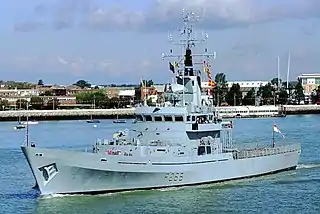Castle-class patrol vessel
The Castle-class was a class of British offshore patrol vessels of the Royal Navy. Two ships were constructed. Both were transferred to the Bangladesh Navy in 2010. The Bangladesh Navy upgraded them with more weapons and sensors. These ships are now reclassified as corvettes by the Bangladesh Navy.
 HMS Dumbarton Castle (P265) | |
| Class overview | |
|---|---|
| Builders: | Hall, Russell & Company |
| Operators: |
|
| Preceded by: | Island class |
| Succeeded by: | River class |
| Built: | 1979–1981 |
| In commission: | 1982–Present |
| Planned: | 6 |
| Completed: | 2 |
| General characteristics | |
| Type: | Offshore patrol vessel |
| Displacement: | 1,427 tons full load |
| Length: | 246 ft (75 m) (overall) |
| Beam: | 37 ft 9 in (11.51 m) |
| Draught: | 11 ft 3 in (3.43 m) |
| Propulsion: | 2 shafts, 2 Paxman diesels, 2,820 hp (2,100 kW) |
| Speed: | 20 knots (37 km/h) |
| Range: | 10,000 nautical miles (19,000 km) at 10 knots (19 km/h) |
| Complement: | 40 |
| Sensors and processing systems: |
|
| Armament: | 1 × Bofors 40 mm gun Mark III, replaced by 1 × 30 mm gun |
| Aviation facilities: | Flight deck capable of supporting a Sea King helicopter |
Design
The Castle-class was designed by David K. Brown and was intended as a series of six offshore patrol vessels for the Royal Navy, designed in response to criticism of the previous Island class for insufficient speed, sub-optimal sea-keeping and lack of a flight deck for rescue helicopters.
In the event, only two ships were built, HMS Leeds Castle and HMS Dumbarton Castle. Both vessels were built by Hall Russell in Aberdeen, Scotland. These had significant improvements over the Island-class – they were 300 tonnes larger, more stable in heavy seas, 3 knots (5.6 km/h) faster and fitted with a large flight deck capable of supporting a Sea King helicopter. For brief periods, the ships could accommodate up to 120 troops.
Their primary mission was to serve with the Fishery Protection Squadron, protecting both the fishing fleets and the oil and gas fields of the North Sea. They could also serve as minelayers, and had detergent spraying facilities on board for dispersing oil slicks.
Operations
After the Falklands War, one ship was kept long-term in the Falkland Islands as a guard ship. Leeds Castle and Dumbarton Castle rotated the role on a three-yearly basis, although the ship's crew usually did a six-month rotation.
Replacement
The Castle-class was replaced in the Falklands by a unique vessel based on the River class, HMS Clyde, and both vessels of the class were decommissioned. Originally due to transfer to the Pakistani Maritime Security Agency in 2007, the deal fell through and both ships were sold to the Bangladesh Navy.[1][2][3]
Ships in class
| Name | Pennant Number | Builder | Laid down | Launched | Commissioned | Fate |
|---|---|---|---|---|---|---|
| Leeds Castle | P258 | Hall, Russell & Company, Aberdeen | 18 October 1979 | 29 October 1980 | 27 August 1981 | Sold to Bangladesh Navy, April 2010 as BNS Dhaleshwari |
| Dumbarton Castle | P265 | 25 June 1980 | 3 June 1981 | 12 March 1982 | Sold to Bangladesh Navy, April 2010 as BNS Bijoy |
References
- "Bangladesh Secures 2 Used British OPVs". Defense Industry Daily. 4 May 2010. Retrieved 6 May 2010.
- "Royal Navy ships sold to Bangladesh". The Scotsman. 26 April 2010. Archived from the original on 29 April 2010. Retrieved 21 May 2010.
- "Shipyard deal safeguards 100 jobs". BBC News. 26 April 2010.
- Conway's All The World's Fighting Ships 1947–1995
- D.K. Brown, "The Design of the Castle Class", a personal view in Warship 2006, Conway's Maritime Press
- Janes Fighting Ships 2007